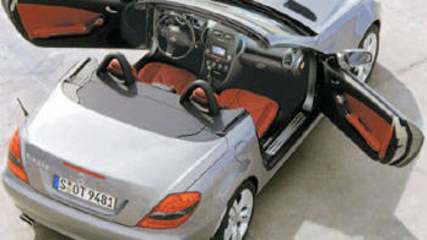2008 Mercedes-Benz SLK280 Reviews
You'll find all our 2008 Mercedes-Benz SLK280 reviews right here. 2008 Mercedes-Benz SLK280 prices range from $13,090 for the SLK-Class SLK280 to $18,150 for the SLK-Class SLK280 .
Our reviews offer detailed analysis of the SLK-Class's features, design, practicality, fuel consumption, engine and transmission, safety, ownership and what it's like to drive.
The most recent reviews sit up the top of the page, but if you're looking for an older model year or shopping for a used car, scroll down to find Mercedes-Benz SLK-Class dating back as far as 2005.
Or, if you just want to read the latest news about the Mercedes-Benz SLK280, you'll find it all here.

Mercedes-Benz SLK 2008 Review
Read the article
By Stuart Innes · 05 Jan 2008
It is being given a makeover for 2008, gaining revised looks, improved interior and more powerful engines. But the German carmaker is doing one of its now-expected tricks by achieving the power increase, along with a small gain in torque, with improved fuel economy and lower exhaust emissions.The SLK, a two-seater sports car, was introduced a decade ago as the smaller brother to the famed SL line of 'Benz sports cars whose price has slipped out of reach of most motorists.The SLK selling now is the second generation, with prices spanning $86,000-$164,000, while the 2008 model is a heavily revised version of that. Mercedes-Benz says it has 650 new parts over the existing model, so it's not just an engine do-up. The 2008 SLK has just been announced in Europe and will go on sale in right-hand-drive in the UK in April.Mercedes-Benz Australia tells Carsguide the new SLK is expected here soon after that, meaning it's only a few months away.The latest technology gets a look-in, too. A new audio and telematics system, NTG 2.5, will be in the SLK and is said to be easier to operate and offers a wider range of functions. The sound system will include a hands-free Bluetooth connection and a new media interface in the glovebox where mobile music devices, such as an iPod, can be connected and operated by the car's audio control system. A new three-spoke steering wheel will carry multifunction buttons. It is part of an interior revision that is aimed at being more driver oriented.It has a new instrument cluster, too.The 2008 SLK can be picked over the existing model by a new front bumper with modified air dam and a more pronounced arrow shape, picking up the feel of the more expensive, bigger SL series. The rear end has a diffuser-style lower section, suggesting more serious performance. And it has darkened tail-light lenses inspired by the Mercedes-Benz performance arm AMG. Larger exterior mirrors include LED turning indicators with a more pronounced arrow shape.The range will start with the SLK 200 Kompressor, a four-cylinder supercharged 1.8-litre where power goes up 15kW to 135kW and torque increases 10Nm to 250Nm — but gives 7.7 litres per 100km.SLK280 is the three-litre V6 good for 170kW but fuel consumption has been cut to 9.3 litres per 100km.Much work has gone into the 3.5-litre V6 engine of the SLK 350. It gains 24kW to 224kW of power at 6500rpm and 10Nm more torque for 360Nm at 4900rpm. The improvements come from changes including a new intake manifold, higher compression ratio and modified valve train.The SLK 350 has a six-speed manual gearbox as standard but the 7G-Tronic automatic transmission that is programmed to blip the throttle on downshifts is appealing.The six-speed manual is standard on SLK models, leaving a five-seed automatic optional on the 200 Kompressor and the seven-speed 7G-Tronic automatic on the 280 and 350 models. The hot-rod SLK 55 AMG retains its 5.5-litre V8 engine of 265kW and 510Nm and 7G-Tronic with paddle shift. SLK has what 'Benz calls a vario roof — a hardtop coupe that converts to open roadster in 22 seconds.Optional in the UK and Europe and to be confirmed for Australia is a direct steering package, which is standard on the 55 AMG.Once the steering angle is past five degrees, the steering ratio increases rapidly for more direct response.It reduces steering-wheel rotations, aimed at making city driving less cumbersome and enabling sweeping, faster roads to be negotiated with only small steering inputs.




